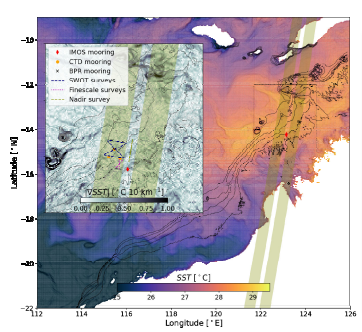[IIOE2-EP47] Quantifying vertical and lateral ocean transport due to submesoscale fronts and eddies
Lead Investigator :
- Nicole Jones,University of Western Australia, Australia
Nicole.jones@uwa.edu.au
Other Key participants (s):
- Matthew Rayson,University of Western Australia,Australia
Matt.rayson@uwa.edu.au - Greg Ivey,University of Western Australia,Australia
Greg.ivey@uwa.edu.au - Shane Keating,U New South Wales,Australia
s.keating@unsw.edu.au - Aurelien Ponte,IFremer, France
aurelien.ponte@ifremer.fr - Jessica Benthuysen,Australian Institute of Marine Science,Australia
j.benthuysen@aims.gov.au - Madi Rosevear,University of Western Australia,Australia
Madi.rosevear@uwa.edu.au - Madi Rosevear,Leibniz Institute for Baltic Sea Research, Germany
jenping.peng@iowarnemuende.de
Period of Project: Jan 2022 - Dec 2024
Brief description of the Project:
This project aims to quantify the intensity and location of submesoscale ocean currents (lessthan 50 km) with unprecedented spatial and temporal resolution in the biologically and economically significant Australian North West Shelf region. Ocean processes at these scales dominate the lateral and vertical transport of ocean borne material, including heat, larvae and pollutants, yet are poorly understood. Our project offers a oncen off opportunity to collect simultaneous in-situ data during the unique rapid-sampling orbit of the pioneering high-resolution SWOT altimetry mission.The target site is one of 14 globally (and the only site in the Indian Ocean) where SWOT will make daily high-resolution measurements of sea surface height during a 3-month window in 2023. A novel spatial array of moorings will support the detailed ship-based observations, together providing critical data for development and testing of new algorithms for estimating ocean surface currents at unprecedented fine scales. This new knowledge will enable characterisation of submesoscale dynamics across broader spatial and time scales, elucidate relationships between mesoscale / submesoscale processes and vertical mixing,and establish physical understanding and data required for parameterisations. Expected outcomes include a paradigm shift in quantification of fine-scale ocean dynamics with global relevance. This novel high-resolution ocean current information is directly applicable for search and rescue,offshore oil and gas operations, defence, ship routing, pollution response and ecosystem assessments in Australian waters. Our observations will advance regional and global-scale ocean model predictions by improving our understanding of important subgridscale processes. The project will therefore bring economic, human safety and environmental benefits to Australia, while providing research training that will build Australian capacity in utilising remotely sensed environmental data and more generally in the space technology sector.
Region of study:
The Australian North West Shelf (NWS) is an environmentally, economically and strategically significant region of the Australian Exclusive Economic Zone and is also a globally important test location for the new SWOT SSH satellite. Past intensive hydrographic surveys and satellite SST have revealed rich eddy fields,with baroclinic instability due to transient lateral density gradients hypothesised as the main submesoscale eddy generation mechanism.The shelf is relatively wide (~250 km) and deep (up to 500 m) and therefore eddies can form and evolve without being impeded by boundaries. From a remote-sensing perspective, the region has some of the best clear-sky conditions on Earth, resulting in greater temporal data coverage for passive instruments, e.g., infrared sensors for SST. Furthermore, the lack of energetic mean flow and smaller surface waves is predicted to result in a greater effective horizontal resolution of the SWOT SSH sensor in tropical regions where it is predicted to resolve wavelengths down to 15 km, i.e., an eddy diameter of 7 km and the minimum submesoscale eddy size is larger in the tropics.Finally, NWS internal tides are large yet predictable compared to other regions. These combined NWS characteristics mean that we will be able to extract higher fidelity estimates of submesoscale ocean currents from remotely-sensed data in this region, making the NWS an important test location globally.


